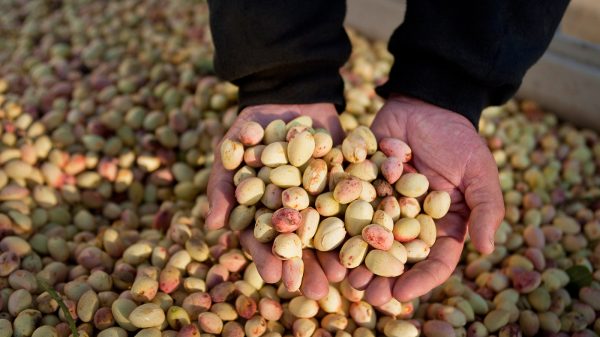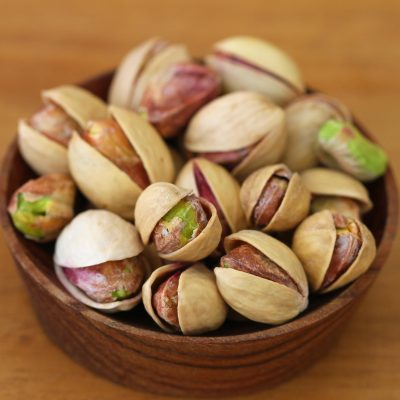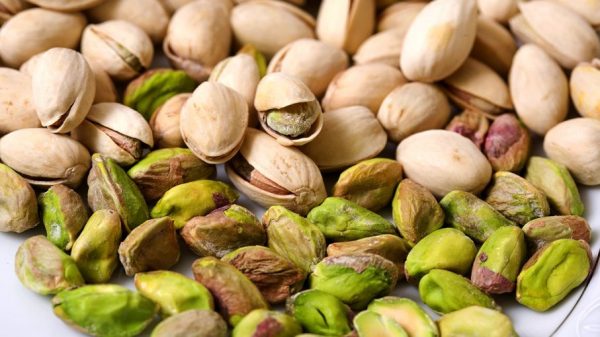pistachio is a small fruit originating in the Middle East and Central Asia. It grows in countries such as Iran, Syria, Turkmenistan and western Afghanistan. The pistachio tree produces a fruit that is edible and very tasty. Peanut is a Persian word that has entered European languages through Latin. One of the most important types of pistachios is Akbari pistachio. |
Introducing pistachio
pistachio is a small fruit originating in the Middle East and Central Asia. It grows in countries such as Iran, Syria, Turkmenistan and western Afghanistan. The pistachio tree produces a fruit that is edible and very tasty. Peanut is a Persian word that has entered European languages through Latin. One of the most important types of pistachios is Akbari pistachio. Peanut is known as the super long pistachio in the world market due to its long, elongated and large brain. This pistachiois one of the most important types of pistachios in the field of trade and is the only major producer of this type of pistachioin Iran. It is mostly harvested in Rafsanjan and Anar cities. The founder of this type of pistachiowas the last Haj Akbar Basanjideh, known as Akbar Tajabadi. This pistachiowas named Akbari pistachio. Haj Akbar died in 2001 in Rafsanjan at the age of 96 and was buried in his hometown of Tajabad village of Rafsanjan city.

Figure1– pistachio
Iranian and American pistachios from the perspective of statistics
The World pistachio Industry is a multibillion dollar business that is gaining market value as its agricultural product grows in popularity. Iran and the United States have monopolized the global Peanut trade and have accounted for a total of 70 to 80 percent of world production over the past decade. In this article, we discuss trade and the amount of Peanut production and export of Iran and the United States as the two main producers of this product in the world. Over the past 40 years, Iranian pistachiogardeners have faced international financial instruments with pressure from sanctions, tariffs and restrictions on their access. Iran’s pistachio industry dates back thousands of years, but pistachiocultivation in the United States began in the 1930s. pistachio trade in the United States grew rapidly after the hostage taking incident and the severance of ties between the two countries in the United States, which was accompanied by sanctions against Iran. Over the next few decades, even in countries with good luck with Iranian pistachios, restrictions on Iranian companies’ access to international financing prevented the country’s pistachio industry from growing in international markets. During this time, the US Peanut market expanded and pistachiocultivation developed, especially in California. But in 2014, the hot, dry climate on the west coast of the United States reduced the pistachio crop by about half, and the industry’s profits for the United States fell sharply in 2015.
Suitable areas for pistachio planting
It is said that economic cultivation means that its planting is affordable. The best place for pistachio cultivation is in an area that is relatively cold in winter, i.e. about 1200 hours below 6 degrees. And since March, when the fruit is green, the temperature needs to be below zero degrees Celsius, and in summer, temperatures above 25 and below 40 degrees Celsius are desirable for this fruit, and relative humidity of about 40 percent is required. Accordingly, different parts of Iran, such as Rafsanjan and Damghan, where pistachiowas grown and cultivated, will no longer be economical for pistachio cultivation because the temperature has risen sharply. Groundwater levels have dropped sharply, with relative air humidity reaching about 10 percent, which means goodbye to pistachiocultivation. On the other hand, there are other cities that are currently experiencing climatic conditions 40 years ago in Rafsanjan and are ideal for growing pistachios. Some of the cities that we can name in Iran in this regard are the cities around Lake Urmia, such as the city of Bonab, and many cities in North Khorasan that have the necessary conditions for pistachiocultivation and harvesting. These conditions include:
- The soil should not be salty and should be relatively fertile.
- The water should not be too salty.
- Possibility of irrigation for about seven days for hybrid or traditional seedlings

Figure2- pistachio
It is noteworthy that pistachios can be grown all over Iran and are meant for an area where planting is economical. And not only does it have the ability to turn green for this fruit. Due to the severe climate change in Iran in recent decades, many areas that were previously favorable are now unfavorable, and many areas that were not previously favorable are now suitable for pistachiocultivation. For example, planting alfalfa around Lake Urmia is no longer logical and should be replaced by pistachio cultivation.
pistachio economy
Iran and the United States are the two largest producers of pistachios in the world. About 70 to 80 percent of the annual pistachio production is in the hands of these two countries. In 1929, the American plant scientist William E. In just six months, Whitehouse found a way to plant and harvest different peanuts in the fields of Iranian pistachioorchards, collecting seeds and freezing them in masse. He returned to the United States with a 20 pound bag of 9 kilograms of seeds. More than 90% of American pistachios are produced in the state of California, and Rafsanjan is the largest producer in Iran. Peanut production in Iran has a history of several thousand years. But pistachioplanting in the United States began in the 1930s with the planting of Iranian Peanut seeds. Following the crisis of hostage taking at the US Embassy in Tehran in November 1979 and the imposition of US and allied sanctions on Iran, the planting of industrial pistachios in the United States flourished. During the years of international sanctions against Iran, American peanuts replaced Iranian pistachios. But with the nuclear deal and a hot, dry wave across the west coast of the United States in 2014, which caused half of the country’s pistachiocrop to be lost, Iranian peanuts have found a new lease of life to enter international markets. American companies, which are currently active in this field, will be a serious competitor for Iranian pistachio companies in the future.

Figure3- pistachio
Iran pistachio production
The average annual production of pistachios in Iran is about 200,000 tons. Only 10% of this product is domestically consumed and the other 90% is exported. Annual consumption of peanuts for each Iranian family is about 2 kg. Iranian pistachioproduction and exports generate about $ 1.4 billion to $ 1.7 billion annually for Iran. In Kerman province, Rafsanjan, Zarand, Sirjan, Anar and Kashkouieh countries are the main centers of pistachioproduction in Iran and 80% of pistachios produced in Iran are obtained from these areas. The cities of Khalilabad, Kashmar and Bardaskan in North Khorasan and areas of South Khorasan, Semnan, as well as the city of Buin Zahra in Qazvin province also account for a significant share of Iran’s pistachioproduction. Although Iranian and American pistachios are of the same breed, Iranian peanuts taste better. And that’s exactly what many major European distributors are endorsing. Seeds and seedlings The first peanuts planted in the United States were Iranian pistachios, which have changed their taste due to soil and climate change, but Turkish peanuts are of a different breed.
World pistachio trade
In 2014, Iran became the world’s largest exporter of peanuts, exporting more than 191,000 tons of peanuts. The United States also became the world’s second largest exporter of pistachios, exporting about 138,000 tons of pistachios. It was the third largest exporter of peanuts in the Turkish world. Turkey was able to export about 3,000 tons of pistachios in 2014 and ranked third in the world in terms of pistachioexports. But one of Iran’s advantages in exporting peanuts is its geographical location. Because with the ease of transportation, Iran can easily capture the market in countries like China.

Figure4- pistachio
Investigating the sales situation of pistachios by Iran’s competitor
The total sales of American pistachios from March 31, 1997 to April 3, were 39,000 tons, which is an increase compared to last year. US domestic sales this month were 11,000 tons. That is, about 1,000 tons, or 8.6 percent, was more than last year, and exports amounted to 28,000 tons. That is about 10,000 tons, up 58 percent from last year. The total cumulative sales of this year’s US product by the end of the seventh trading month were reported at 247,000 tons, an increase of 18 percent from 37,000 tons a year earlier. Gross domestic product in the United States was reported at 73,000 tons, up 6 percent from 4,000 tons last year. By the end of March, about 174,000 tons of pistachios had been exported, an increase of 24 percent from 33,000 tons last year. US pistachiosales have always held a record since the beginning of September until today, except in December. Sales in March this year were much higher than in the same period last year, thanks to a 58 percent increase in exports. It should be noted that the sharp decline in Iranian production was the main reason for the increase in US pistachioexports to target markets. So much so that it accounted for 71 percent of US total exports. Europe and Asia, and especially China, are the largest export destinations for American pistachios. March sales to European customers increased by 80% and to Chinese sales by 94% compared to the previous month. It goes without saying that this significant increase in sales to target markets is based on prices that traded at $ 8.14 to $ 8.36 per kilogram at the beginning of the season. Another significant increase in sales is that despite the gradual rise in prices, from $ 9.68 to $ 9.90 and now to $ 10.12 per kilo, sellers are sticking to their initial commitments at the time of the contract.

Figure5- pistachio
Challenges of pistachio production
While in the mid-1980s, Iran’s pistachioproduction was more than 250,000 tons, this figure dropped to 150,000 tons in the early 1990s. Consecutive droughts are the biggest problem in pistachio production, and the lack of planning to provide water for pistachioorchards, as well as cumbersome export laws and regulations, have caused Iran’s pistachioexports to plummet in recent years. At the same time, with the increase in pistachio production in the US state of California, this country is becoming the first exporter of this product in the world. The United States produces pistachios mechanized, making it 3 tons per hectare and three times Iran’s production per hectare. Under these circumstances, in 2014, Iran’s pistachioexports to European countries decreased from 90,000 tons per year to 10,000 tons. Another problem for exporters is the indiscriminate use of poison in pistachio orchards, which threatens Iran’s small share of peanuts in European markets. The European Union has strict rules in this regard, and if this market is lost, American pistachios will soon take over the Iranian market in Europe.
